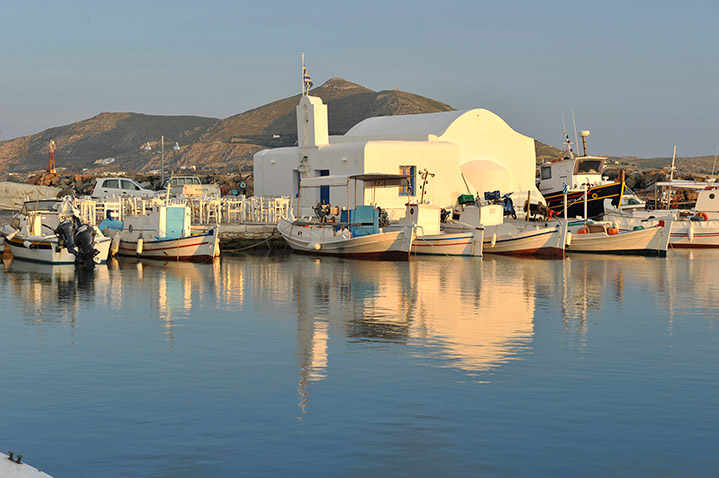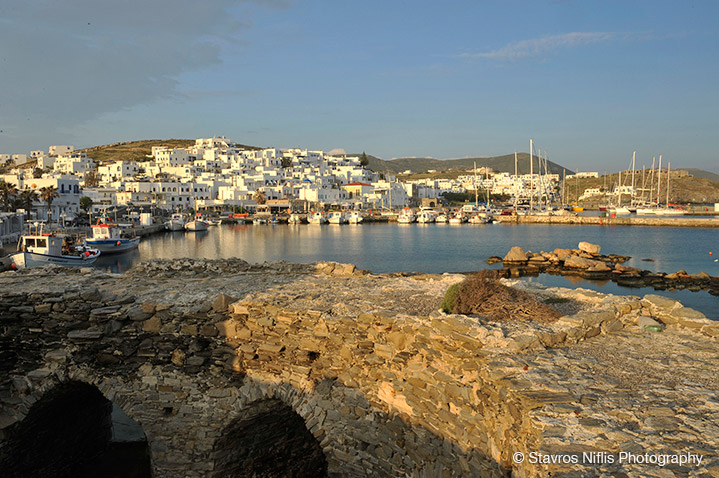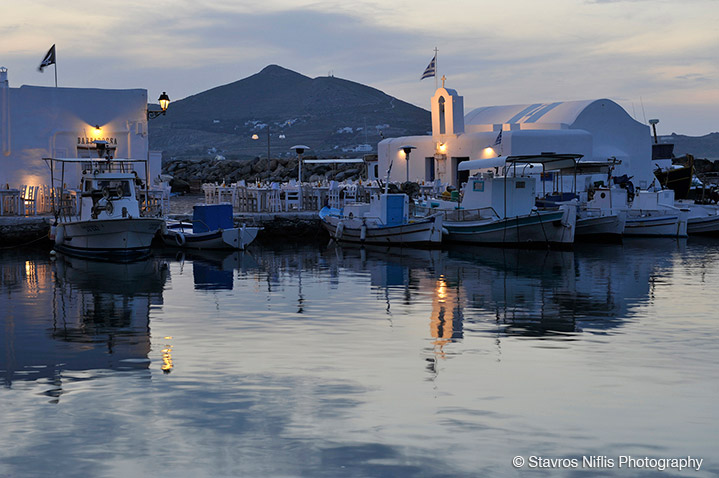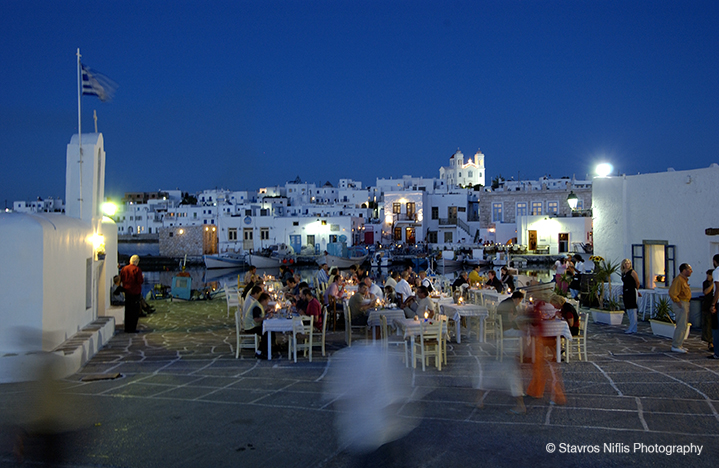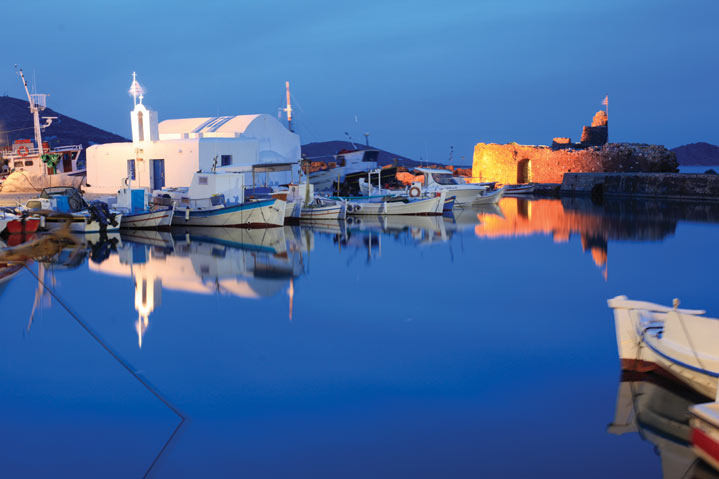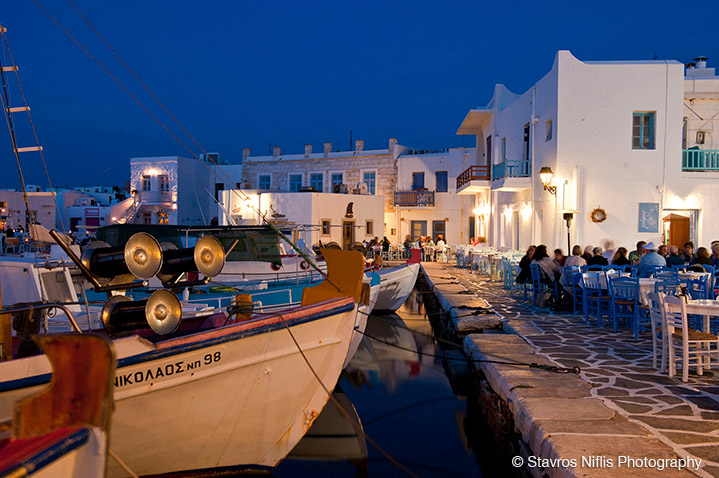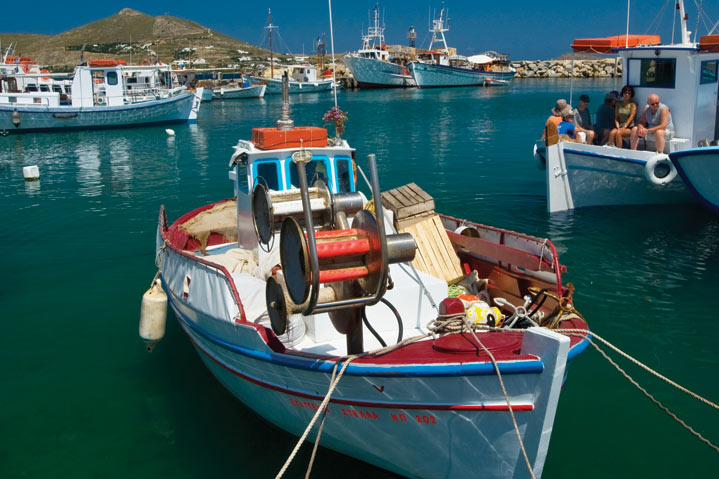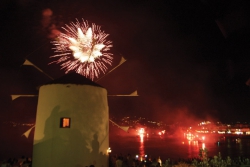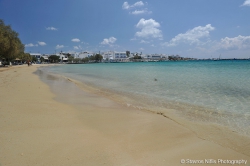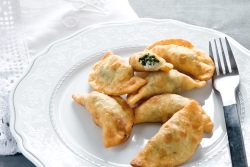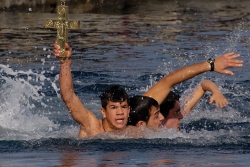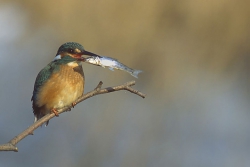Naoussa
Naoussa, the second largest village of the island with the largest fishing fleet in the Cyclades, is on the north shore of the island and boasts beautiful Venetian architecture.
The villages of Ambelas, Santa Maria, Ag. Anargyri, Kolybithres and Kamares are nearby, as well as beautiful beaches at Piperi, Fykia, Kolybithres, Monastiri, Ag. Anargyri, Xifara, Lageri, Santa Maria, Ampelas and Damoulis.
Naoussa was built around the port in the Byzantine era. It was fortified by a wall that led to a Venetian bastion (Kastelli), parts of which still stand and are of great historical and archaeological interest. It is worth noting that the port of Naoussa formed the headquarters of the Russian fleet during the occupation of 1770 led by the Orloffs.
Today, the lovely and sheltered port is always filled with fishing boats and fisherman returning with fresh fish and seafood. Naoussa is one of the most beautiful fishing villages in Greece, and retains both its authentic island character and cosmopolitan glamor.
Today, the old warehouses formerly belonging to the fisherman have been turned into taverns, cafés and ouzo restaurants that serve fresh seafood. The cafés and bars create an atmosphere in the evening that attracts people from all over the island, who party until dawn.
Visitors venturing into the heart of Naxos will discover a network of narrow streets, whitewashed and bright, in accordance with the traditional Cycladic style that accentuates the culture of the island and harmoniously unifies the mansions and glory of the past with the modern present.
Residents of Naoussa are lively people who revel in a good party, dance and song. The wine and fish festival is held every summer, on the first Sunday in July. The Koursariki (pirate) night on 23 August is an important celebration with a representation of pirates looting the village and features fireworks and a large feast with plenty of wine and seafood delicacies for everyone.
There are six monasteries around Naoussa, where visitors can admire the ornate icon screens, wall paintings and original architectural style. (Monastery of Loggovardas, Agios Ioannis Detis, Cathedral of the Assumption (Kimisis tis Theotokou), monastery of Agios Athanasios, Agios Georgios medieval church).
The Byzantine and post-Byzantine era is captured by the old houses and small, but historic churches in the general area.
The following sites are also found in Naossa:
Mycenaean acropolis (Koukounaries) - one of the most important archaeological sites in the region, the Mycenaean acropolis built in 1200 BC was found in Koukounaries. Archaeological findings from the excavation are exhibited at the Archaeological Museum.
Early Cycladic cemetery (Plastira) - many interesting idols and graves have been found, whose characteristics indicate that they date back to the early Cycladic period.
Venetian castle fort on the north side of the harbor.
The Folklore Museum of Naoussa exhibits the collection of Doctor Othon Kaparis and also comprises a library, rich photographic archive and some archaeological findings.
The Folklore Collection of Naoussa proudly exhibits male and female dress from various regions of Hellenism and, of course, Paros. There are also everyday objects and old photographs that will introduce visitors to a Paros from another era.
The villages of Ambelas, Santa Maria, Ag. Anargyri, Kolybithres and Kamares are nearby, as well as beautiful beaches at Piperi, Fykia, Kolybithres, Monastiri, Ag. Anargyri, Xifara, Lageri, Santa Maria, Ampelas and Damoulis.
Naoussa was built around the port in the Byzantine era. It was fortified by a wall that led to a Venetian bastion (Kastelli), parts of which still stand and are of great historical and archaeological interest. It is worth noting that the port of Naoussa formed the headquarters of the Russian fleet during the occupation of 1770 led by the Orloffs.
Today, the lovely and sheltered port is always filled with fishing boats and fisherman returning with fresh fish and seafood. Naoussa is one of the most beautiful fishing villages in Greece, and retains both its authentic island character and cosmopolitan glamor.
Today, the old warehouses formerly belonging to the fisherman have been turned into taverns, cafés and ouzo restaurants that serve fresh seafood. The cafés and bars create an atmosphere in the evening that attracts people from all over the island, who party until dawn.
Visitors venturing into the heart of Naxos will discover a network of narrow streets, whitewashed and bright, in accordance with the traditional Cycladic style that accentuates the culture of the island and harmoniously unifies the mansions and glory of the past with the modern present.
Residents of Naoussa are lively people who revel in a good party, dance and song. The wine and fish festival is held every summer, on the first Sunday in July. The Koursariki (pirate) night on 23 August is an important celebration with a representation of pirates looting the village and features fireworks and a large feast with plenty of wine and seafood delicacies for everyone.
There are six monasteries around Naoussa, where visitors can admire the ornate icon screens, wall paintings and original architectural style. (Monastery of Loggovardas, Agios Ioannis Detis, Cathedral of the Assumption (Kimisis tis Theotokou), monastery of Agios Athanasios, Agios Georgios medieval church).
The Byzantine and post-Byzantine era is captured by the old houses and small, but historic churches in the general area.
The following sites are also found in Naossa:
Mycenaean acropolis (Koukounaries) - one of the most important archaeological sites in the region, the Mycenaean acropolis built in 1200 BC was found in Koukounaries. Archaeological findings from the excavation are exhibited at the Archaeological Museum.
Early Cycladic cemetery (Plastira) - many interesting idols and graves have been found, whose characteristics indicate that they date back to the early Cycladic period.
Venetian castle fort on the north side of the harbor.
The Folklore Museum of Naoussa exhibits the collection of Doctor Othon Kaparis and also comprises a library, rich photographic archive and some archaeological findings.
The Folklore Collection of Naoussa proudly exhibits male and female dress from various regions of Hellenism and, of course, Paros. There are also everyday objects and old photographs that will introduce visitors to a Paros from another era.








